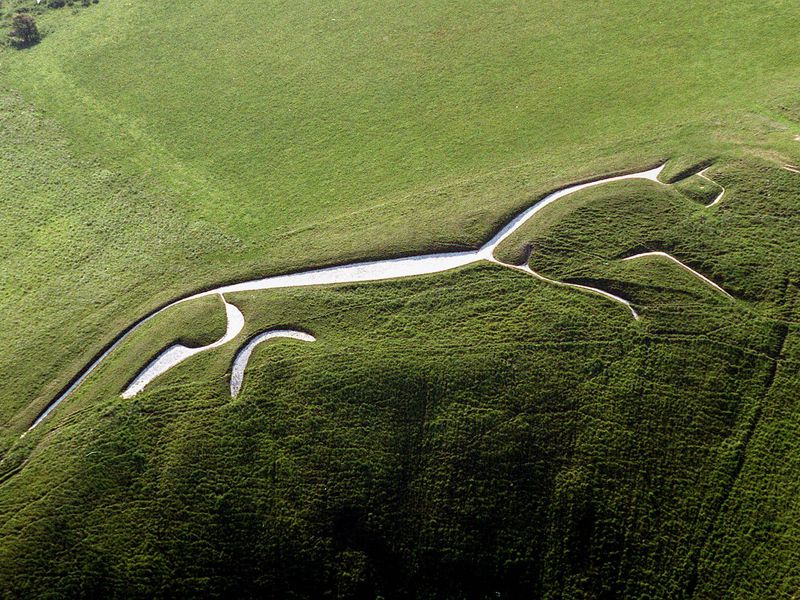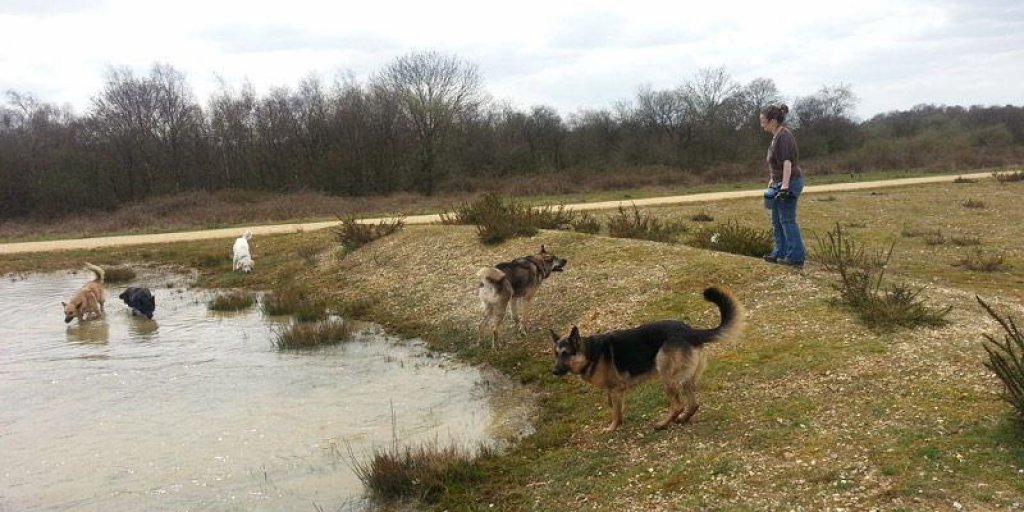Fascinating almost beyond words.
In the days when I lived in South Devon in England and had cause to travel, as in drive, to London one of the route options was to take the M5 motorway (Freeway in American speak) up to Bristol and then follow the M4 motorway that ran from Bristol all the way into the outskirts of London.
One of the benefits of this was that half-way, give or take, was at the Swindon exit and a further ten-minute drive took one to the delightful car-park at the White Horse at Uffington. No, it wasn’t a pub despite numerous pubs in England being called The White Horse; it was something much more special.

Yes, this is the very ancient White Horse that is introduced in Wikipedia, thus:
The Uffington White Horse is a highly stylised prehistoric hill figure, 110 m (360 ft) long, formed from deep trenches filled with crushed white chalk. The figure is situated on the upper slopes of White Horse Hill in the English civil parish of Uffington (in the county of Oxfordshire, historically Berkshire), some 8 km (5 mi) south of the town of Faringdon and a similar distance west of the town of Wantage; or 2.5 km (1.6 mi) south of Uffington. The hill forms a part of the scarp of the Berkshire Downs and overlooks the Vale of White Horse to the north. The best views of the figure are obtained from the air, or from directly across the Vale, particularly around the villages of Great Coxwell, Longcot and Fernham. The site is owned and managed by the National Trust and is a Scheduled Ancient Monument. The Guardian stated in 2003 that “for more than 3,000 years, the Uffington White Horse has been jealously guarded as a masterpiece of minimalist art.” It has also inspired the creation of other white horse hill figures.
So what prompted today’s post?
A recent article published online by The Smithsonian. Read and be amazed!
ooOOoo
Against All Odds, England’s Massive Chalk Horse Has Survived 3,000 Years
Cleaning up the Uffington Horse is the neigh-borly thing to do

July 6, 2017
If you stand in the valley near the village of Uffington in Oxfordshire, England, and look up at the high curve of chalk grassland above you, one thing dominates the view. Across the flank of the hill runs an enormous white, abstract stick figure horse cut from the chalk itself. It has a thin, sweeping body, stubby legs, a curiously long tail and a round eye set in a square head.
It’s chalking day, a cleaning ritual that has happened here regularly for three millennia. Hammers, buckets of chalk and kneepads are handed out and everyone is allocated an area. The chalkers kneel and smash the chalk to a paste, whitening the stony pathways in the grass inch by inch. “It’s the world’s largest coloring between the lines,” says George Buce, one of the participants.
Chalking or “scouring” the horse was already an ancient custom when antiquarian Francis Wise wrote about it in 1736. “The ceremony of scouring the Horse, from time immemorial, has been solemnized by a numerous concourse of people from all the villages roundabout,” he wrote.
In the past, thousands of people would come for the scouring, holding a fair in the circle of a prehistoric fort nearby. These days it’s a quieter event. The only sounds are the wind, distant birdsong and the thumping of hammers on the chalk that can be felt through the feet.
Conservation organization the National Trust oversees the chalking, making sure the original shape of the horse is maintained. But the work is done by anyone who wants to come along. Lynda Miller is working on the eye, a circle the size of a car wheel. “The horse has always been part of our lives,” she says. “We’re really excited that we’re cleaning the eye today. When I was a little girl and I came here with my mother and father, the eye was a special spot. We used to make a wish on it.”
National Trust ranger Andy Foley hands out hammers. “It must have happened in this way since it was put on the hillside,” he says. “If people didn’t look after it the horse would be gone within 20 to 30 years; overgrown and eroded. We’re following in the footsteps of the ancients, doing exactly what they did 3,000 years ago.”
“There is something very special about this landscape that attracts people,” says archaeologist David Miles. In the 1990s, he led an excavation of the site that established the prehistoric date for the horse. Before the excavation, it was thought that the design was only scratched into the chalk surface, and therefore un-datable, but Miles’ team discovered the figure was actually cut into the hill up to a meter deep. That meant it was possible to use a technique called optical stimulated luminescence to date layers of quartz in the trench.


Up on the hill it’s not possible to view the whole horse at once; the curve of the slope gets in the way, the sheer scale of it confuses the eye. It is only from the valley below that the whole picture can be taken in. From this long distance, the horse is a tiny white figure prancing timelessly across the brow of the hill. But to the people who live near and tend the horse, it’s a monumental reminder of Britain’s ancient past.
“It was older than I’d been expecting,” Miles remembers. “We already knew it must be ancient, because it’s mentioned in the 12th-century manuscript The Wonders of Britain, so it was obviously old then. And the abstract shape of the horse is very similar to horses on ancient British coins just over 2,000 years old. But our dating showed it was even older than that. It came out as the beginning of the Iron Age, perhaps even the end of the Bronze Age, nearly 3,000 years ago.”
The trenches would have been dug out using antler picks and wooden spades: tough, labor-intensive work. How the builders planned and executed such a large figure when the full effect can only be taken in from several miles away is still a mystery.
Nobody knows for certain why the horse was made. “It’s a beautiful shape, very elegant,” says Miles. “It looks like it’s bounding across the hillside. If you look at it from below, the sun rises from behind it and crosses over it. In Celtic art, horses are often shown pulling the chariot of the sun, so that may be what they were thinking of here.”
From the start the horse would have required regular upkeep to stay visible. It might seem strange that the horse’s creators chose such an unstable form for their monument, but archaeologists believe this could have been intentional. A chalk hill figure requires a social group to maintain it, and it could be that today’s cleaning is an echo of an early ritual gathering that was part of the horse’s original function.
The Berkshire Downs where the horse lies are scattered with prehistoric remains. The Ridgeway, Britain’s oldest road, runs nearby. This is the heart of rural England and the horse is one of the country’s most recognizable landmarks, an identity badge stamped into the landscape. During World War II, it was covered over with turf and hedge trimmings so Luftwaffe bombers couldn’t use it for navigation. (Oxford is about a 30-minute drive and London about an hour-and-a-half.)
For locals, it’s part of the backdrop of daily life. Residents in the village reportedly arrange their rooms so that they sit facing the horse. Offerings, flowers, coins and candles are left on the site.
The people who come to the chalking have a variety of motivations. Martha Buckley is chalking the horse’s neck. ” I’m a neo-Pagan and I feel it connects me to the land. It’s of great spiritual significance,” she says. Lucy Bartholomew has brought her children. “It’s good to be able to explain to them why it’s here.” For Geoff Weaver, it’s the imperative to preserve history. “If we don’t do it, it would disappear, and the world would be a sorrier place,” he says.
ooOOoo
There are more fascinating photographs to view in that Smithsonian article.
Speaking of Berkshire, as in the Berkshire Downs, the only way to close today’s post is with a link to a dog walk on Greenham Common in Berkshire. That includes the following photograph.

Have a great weekend all of you!
What an interesting post and brings back memories of traveling in the U.K.
LikeLike
Sister, dear sister, what a treat to find you gracing these pages. Thank you.
LikeLike
Very interesting read, Paul. I find artifacts like the horse to be fascinating. The cleaning process or scouring does look labor intensive & tedious.
LikeLike
Not only today but for thousands of years in the past. When you walk close to that ancient image it really does stir some very deep feelings. Delighted you found it interesting, Susan.
LikeLiked by 1 person
I did!
LikeLike
How interesting! I never knew or heard anything before in my life about this horse. This is an extremely fascinating thing. Thank you for sharing.
LikeLike
That’s nice! Always my pleasure to share stuff with you and everyone else.
LikeLiked by 1 person
I first saw the horse when it was used as the cover art of ‘English Settlement’ by the Swindon based band, XTC.
I didn’t know it was regularly scoured, makes me want to schedule travel there to help scour!
LikeLike
Yes, what a great idea. If I was still living in the Southwest of England I would probably want to join them as well.
LikeLike
I almost always learn something when I read your blog. Thank you for this. 3000 years old. I am thinking about the people who created this piece of beautiful art, people who had to struggle daily just to survive. What a commitment this was. I’m so glad it still exists today. A tribute to the English people that have preserved it for so many centuries
LikeLike
Kim, you flatter me! 😊 For I’m sure you don’t truly learn every single time. But it’s a lovely response!
LikeLike
I did say “almost”, but it is true.
LikeLike
😍
LikeLike
Lovely to hear about the community spirit to keep the white horse historical significance alive and well! The world needs a lot more of this sort of ‘inclusive’ bonding. We seem to react in very positive ways when we find common goals. 😄
LikeLike
Absolutely! Well said, and thank you!
LikeLike
The lines are gorgeous. Like the art at Lascaux and Altamira, the work is mindbogglingly superb.
LikeLike
Such clean, expressive lines that could have come from the hand of a Parisian left-bank artist 50 years ago. Oh, to truly appreciate the culture and customs of those Celtic groups from so far back. John, delighted you had such a response to today’s post.
LikeLiked by 1 person
Holy cow, er horse, er…gosh…that is just amazing! Love the comment about it being the world’s largest coloring between the lines! Fabulous, just fabulous. And impressive that it’s a ritual community project keeping it that way.
LikeLike
Being kept that way in a tradition that goes back more than 3,000 years. In today’s ‘flip-flop’ world I find that continuity very inspiring.
Lovely reply from you! Thank you so much!
LikeLiked by 1 person
I love the honoring it does for things from the past. Over here, we tend not to have the same ethos. 😦
LikeLike
I hadn’t thought about that before, Would that be because the history of people here only goes back a very short way, by comparison?
LikeLiked by 1 person
Well that certainly, but probably more from arrogance, I’m sorry to think.
LikeLike